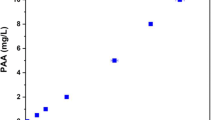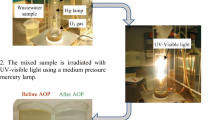Abstract
The use of peracetic acid (PAA) in the disinfection of sanitary effluents has been proposed by various authors. However, there are still doubts about its influence on the physical–chemical characteristics of the effluent after application. In the present study, it was observed that the composition of PAA leads to an increase in organic material, resulting in an increase of approximately 20 mg/L in the chemical oxygen demand of the effluent for every 10 mg/L of PAA applied. According to the kinetic tests, the degradation of PAA in the effluent was represented by a first-order reaction and its half-life in the effluent was estimated at 79 min. The formation of by-products resulting from degradation of PAA in the effluent was evaluated by considering by-products already detected by other authors in disinfection trials, these being nonanal, decanal, chlorophenols, and 1-methoxy-4-methylbenzene, which were not observed in the effluent being studied after application of PAA at a dosage of 10 mg/L.








Similar content being viewed by others
References
APHA/AWWA/WEF. (1998). Standard methods of the examination of water and wastewater. 20th ed. APHA (American Public Health Association) CD-ROM. USA.
Baldry, M. G. C., & French, M. S. (1989). Disinfection of sewage effluent with peracetic acid. Water Science and Technology, 21(3), 203–206.
Baldry, M. G. C., Cavadore, A., French, M. S., Massa, G., Rodrigues, L. M., Schirch, P. F. T., & Threadgold, T. L. (1995). Effluent disinfection in warm climates with peracetic acid. Water Science and Technology, 31(5–6), 161–164.
Block, S. S. (2001). Disinfection, sterilization, and preservation (5th ed., p. 1481). Philadelphia: Lippincott Williams & Wilkins.
Booth, R. A., & Lester, J. N. (1995). The potential formation of halogenated by-products during peracetic acid treatment of final sewage effluent. Water Research, 29(7), 1793–1801.
Brasileiro, L. B., Colodette, J. L., Piló-Veloso, D. (2001). A utilização de perácidos na deslignificação e no branqueamento de polpas celulósicas. São Paulo: Quím. Nova, 24 (6).
CONAMA (National Council of Environment (Brazil)). (2005) Resolution 357/2005. http://www.mma.gov.br/port/conama/res/res05/res35705.pdf. Accessed 10 June 2010.
Costa, J. B. (2007). Ecotoxicological evaluation of wastewater secondary treatment of sewage after disinfection with peracetic acid, chlorine, ozone, ultraviolet radiation. Thesis. University of São Paulo (in Portuguese).
Crebelli, R., Conti, L., Monarca, D., Feretti, D., Zerbini, I., Zani, E. V., Cutilli, D., & Ottaviani, M. (2005). Genotoxicity of the disinfection by-products resulting from peracetic acid- or hypochlorite-disinfected sewage wastewater. Water Research, 39, 1105–1113.
Falsanisi, D., Gehr, R., Santoro, D., Dell'erba, A., Notarnicola, M., & Liberti, L. (2006). Kinetics of PAA demand and its implications on disinfection of wastewaters. Water Quality Research Journal of Canada, 41(4), 398–409.
Falsanisi, D., Gehr, R., Liberti, L., & Notarnicola, M. (2008). Effect of suspended particles on disinfection of a physicochemical municipal wastewater with peracetic acid. Water Quality Research Journal of Canada, 43(1), 47–54.
Kitis, M. (2004). Disinfection of wastewater with peracetic acid: a review. Environment International, 30, 47–55.
Koivunen, J., & Heinonen-Tanski, H. (2005). Peracetic acid (PAA) disinfection of primary, secondary and tertiary treated municipal wastewaters. Water Research, 39, 4445–4453.
Lazarova, V., Janex, M. L., Fiksdal, L., Oberg, C., Barcina, I., & Pommepuy, M. (1998). Advanced wastewater disinfection technologies: short and long term efficiency. Water Science and Technology, 38(12), 109–117.
Monarca, S., Zani, C., Richardson, S., Thruston, A. D., Moretti, M., Feretti, D., & Villarini, M. (2004). A new approach to evaluating the toxicity and genotoxicity of disinfected drinking water. Water Research, 38, 3809–3819.
Nurizzo, C., Antonelli, M., Profaizer, M., & Romele, L. (2005). By-products in surface and reclaimed water disinfected with various agents. Desalination, 176, 241–253.
Rossi, S., Antonelli, M., Mezzanofte, V., & Narizzo, C. (2007). Peracetic acid disinfection: a feasible alternative to wastewater chlorination. Water Environment Research, 79(4), 341–350.
Sanchez-Ruiz, C., Martinez-Royano, S., & Tejero-Monzon, I. (1995). An evaluation of the efficiency and impact of raw wastewater disinfection with peracetic acid prior to ocean discharge. Water Science and Technology, 32(7), 159–166.
Sartori, L. (2004) Adequacy of the microbiological quality of secondary effluents from wastewater by application of disinfectants ozone, potassium permanganate and peracetic acid. Thesis. University of São Paulo (in Portuguese).
Shikishima, R.T.K., Ribeiro, W.B.;,Kunigk, L. (2008). The influence of temperature and salinity on the kinetics of decomposition of peracetic acid solutions in saline water. Rio de Janeiro: 48th Brazilian Congress of Chemical Engineering (in Portuguese).
Souza, J. B. (2006). Evaluation method for disinfecting water employing chlorine, peracetic acid, ozone and disinfection process combined chlorine/ozone. Thesis. University of São Paulo (in Portuguese).
Sperling, M. V. (2005). Principles of biological treatment of wastewater. Belo Horizonte: UFMG (in Portuguese).
Stampi, S., De Luca, G., & Zanetti, F. (2001). Evaluation of the efficiency of peracetic acid in the disinfection of sewage effluents. Journal of Applied Microbiology, 91, 833–838.
Veschetti, E., Cutilli, D., Bonadonna, L., Briancesco, R., Martini, C., Cecchini, G., Anastasi, P., & Ottaviani, M. (2003). Pilot-plant comparative study of peracetic acid and sodium hypochlorite wastewater disinfection. Water Research, 37, 78–94.
Zar, J. H. (1999). Biostatistical analysis. Upper Saddle River: Prentice-Hall. 662.
Zhao, X., Zhang, T., Zhou, Y., & Liu, D. (2007). Preparation of peracetic acid from hydrogen peroxide, part I: kinetics for peracetic acid synthesis and hydrolysis. Journal of Molecular Catalysis A: Chemical, 271, 246–252.
Zhao, X., Cheng, K., Hao, J., & Liu, D. (2008). Preparation of peracetic acid from hydrogen peroxide, part II: kinetics for spontaneous decomposition of peracetic acid in the liquid phase. Journal of Molecular Catalysis A: Chemical, 284, 58–68.
Author information
Authors and Affiliations
Corresponding author
Rights and permissions
About this article
Cite this article
Cavallini, G.S., de Campos, S.X., de Souza, J.B. et al. Evaluation of the Physical–Chemical Characteristics of Wastewater After Disinfection with Peracetic Acid. Water Air Soil Pollut 224, 1752 (2013). https://doi.org/10.1007/s11270-013-1752-5
Received:
Accepted:
Published:
DOI: https://doi.org/10.1007/s11270-013-1752-5




